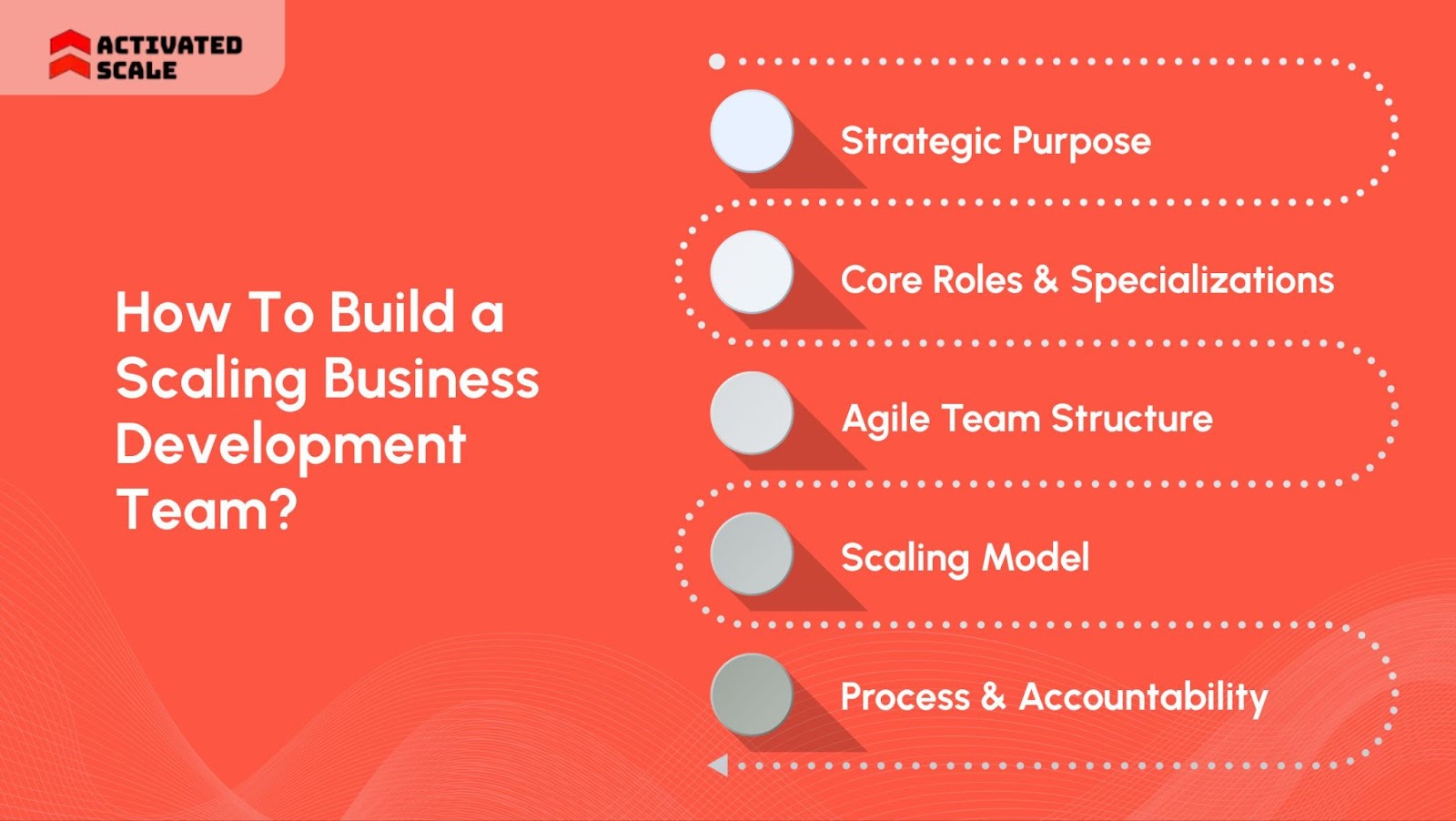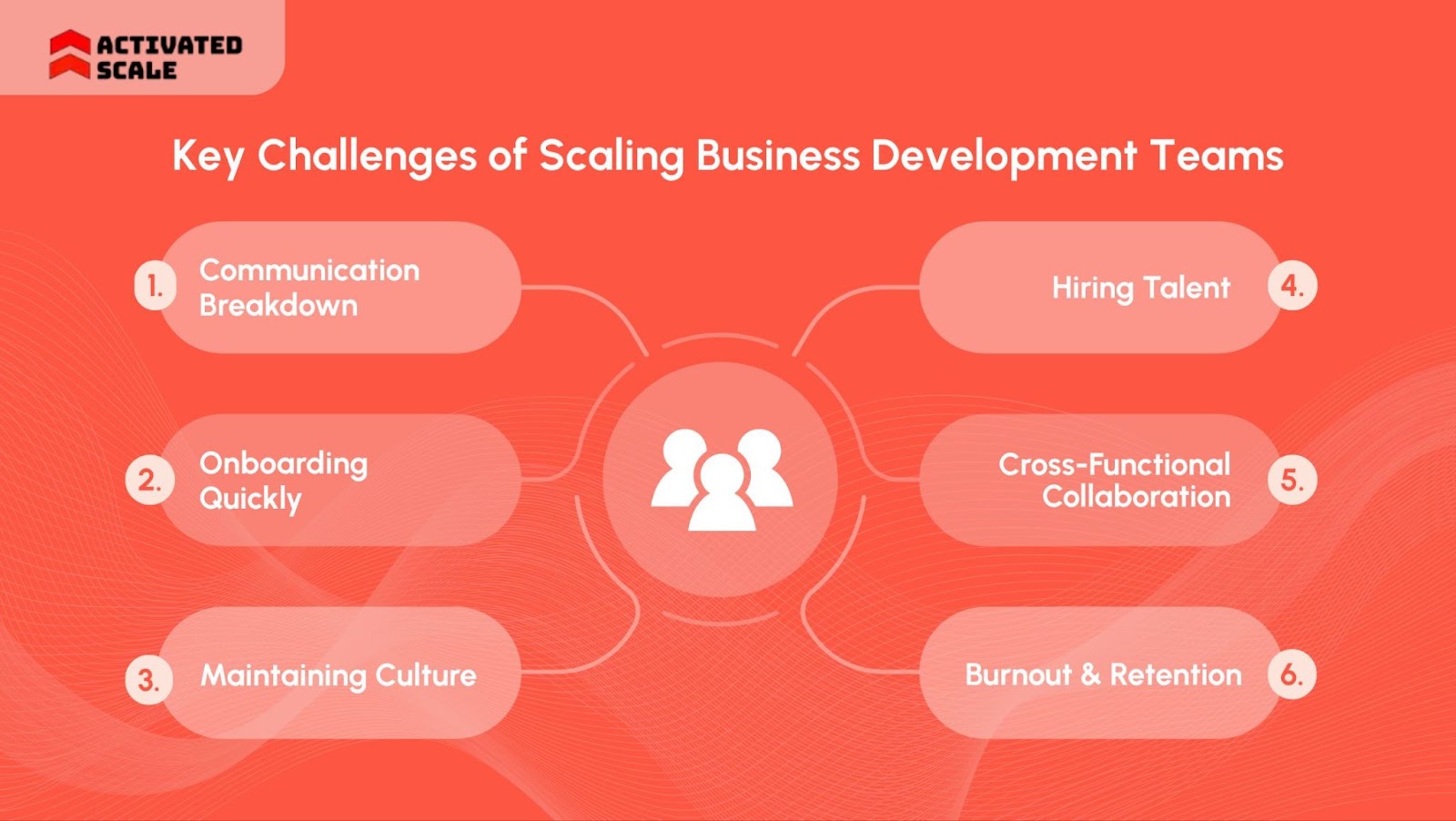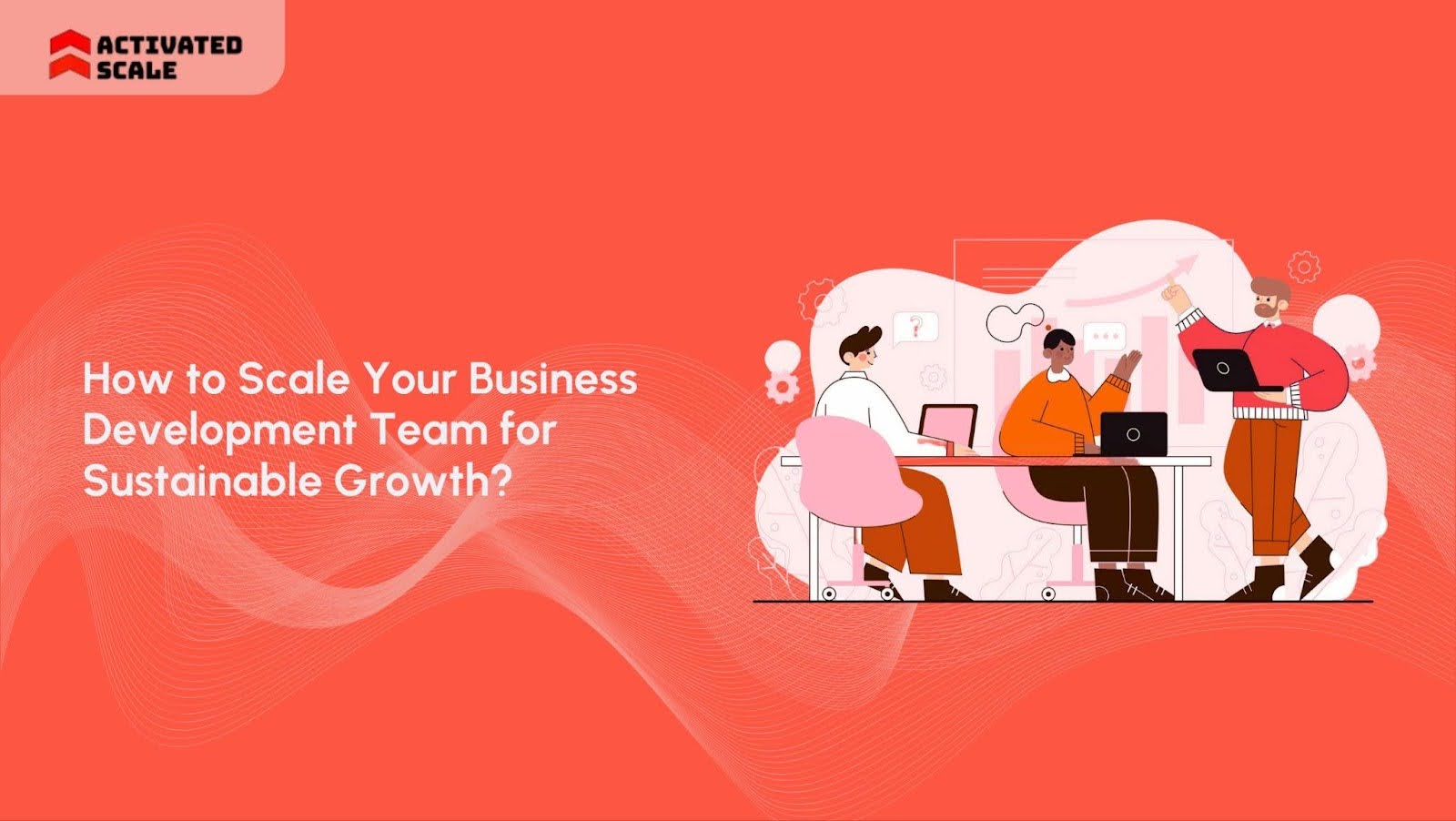Did you know that nearly 90% of startups and fast-growth companies fail to achieve their intended scale? It is not because of a poor product, but because of missteps in team building and execution.
In fact, 87% of sales leaders admit they lack a standardized approach for scaling their teams, often resulting in missed quotas and team inefficiencies.
Scaling a business development team is about weaving together the right structure, culture, and processes to unlock new levels of opportunity. Those who scale well create a flywheel for growth; they open new markets, nurture long-term customer value, and build a foundation for enduring success.
This guide is designed to better your understanding of how to scale business development teams the right way.
In a Nutshell
- Successfully scaling business development teams requires balancing strong leadership, flexible talent models, and a supportive culture.
- Fractional and contract-to-hire sales talent provide agile, cost-effective solutions for rapid growth, interim leadership, and testing new approaches.
- Key challenges during scaling include maintaining communication, consistency, and alignment across expanding teams and processes.
- Activated Scale connects businesses with vetted fractional sales leaders and contract-to-hire professionals, offering flexible expertise to accelerate and sustain growth.
Why (and When) Should You Scale Your Business Development Team?
Recognizing the right moment and motivation to scale a business development team separates proactive growth from costly overreach.
Successful organizations treat scaling as a strategic response to clearly observable signals in their business environment.
Key Signals That It’s Time to Scale
Why Scaling Matters?
Failure to scale at the right time increases project delays by 37%, doubles technical debt, and leads to burnout, directly eroding competitive advantage.
Scaling business development teams is a strategic imperative that directly influences the velocity, quality, and sustainability of growth.
- Seizing Market Opportunities: In rapidly evolving sectors, being able to quickly mobilize and focus business development efforts is a key competitive advantage.
- Sustaining Growth: Scaling BD ensures that pipeline generation and relationship-building grow in lockstep with other business functions, supporting not just spikes of growth but enduring, repeatable results.
- Specialization and Focus: Expanding the team creates space for role specialization (such as account mapping, partner development, or vertical-specific outreach), making the group more effective and efficient.
- Reducing Burnout and Maintaining Culture: Overextended teams are a recipe for stress, decreased morale, and high turnover. Scaling at the right juncture protects both performance and team well-being.
Timing Is Everything
Scaling too soon can dilute resources, create confusion, and increase overhead without clear ROI. Waiting too long means missed opportunities and overworked teams.
The ideal timing is when growth potential clearly EXCEEDS current capacity, validated by pipeline data, market feedback, or customer demand.
How To Build a Scaling Business Development Team?

Structures that align specialized roles and coherent workflows create agility and resilience in business development teams.
Such frameworks support sustained performance amid expanding markets, evolving product lines, and intensifying competitive pressures, allowing teams to adapt rapidly without sacrificing focus or cohesion.
Step 1: Start with Strategic Purpose
Every scalable structure begins with a clear understanding of business goals and target markets.
- Define near-term and long-term objectives: Market entry, expansion, product launch, or vertical penetration each demand distinct strengths from the BD team.
- Clarify the Ideal Customer Profile (ICP): Aligning team efforts with a well-defined ICP ensures focus in both outreach and resource allocation.
Step 2: Map Core Roles and Specializations
Scaling demands more than more BD reps, it requires the right mix of roles and expertise.
Core roles can include:
- Business Development Representatives (BDRs)
- Account Executives (AEs)
- Partner Managers/Channel Specialists
- Market Researchers or Lead Generation Specialists
- BD Operations/Enablement
Role Specialization Table (example):
Step 3: Choose an Agile Team Structure
Rigid hierarchies buckle under growth; adaptable frameworks unlock velocity and resiliency.
- Pod Model: Small, cross-functional teams (BDR + AE + ops/support) focused on specific segments, products, or verticals. Promotes autonomy and accountability.
- Squad/Tribe Model: Larger networks of pods (or squads) united by shared goals but working on parallel initiatives. Common among fast-growing startups and SaaS companies.
- Hybrid or Matrix Structure: Combines traditional reporting lines with cross-functional project teams, ensuring both alignment and specialized focus.
Tip: Pod and squad structures outperform rigid models in organizations where rapid iteration and feedback are critical.
Step 4: Choosing the Right Scaling Model
Scaling a business development team is about selecting the right model for your growth, flexibility, and resource needs. Each model addresses different stages of company maturity, risk appetite, and strategic goals. Here’s a nuanced look at each approach:
- In-House Model
Building a team of full-time BD professionals embedded within your company.
- Strengths: Deep cultural alignment, strong long-term commitment, tighter control over process and learning.
- When to use: Ideal when you have stable, predictable growth, and the budget to invest in permanent headcount.
- Outsourced Model
Partnering with external agencies or vendors who provide BD services on your behalf.
- Strengths: Fast ramp-up, built-in expertise, broader industry perspective, and no long-term employment obligations.
- When to use: Entering new markets, validating hypotheses, or supplementing internal bandwidth for short-to-medium-term campaigns. 79% of businesses using sales outsourcing expanded faster.
- Fractional Model
Engaging seasoned professionals or specialized sellers part-time or for specific projects, gaining executive-level impact without the full-time cost.
- Strengths: Immediate, senior expertise; targeted for gap-filling, high-impact projects, or interim needs. Offers strategic agility and cost control, fractional roles have driven up to 40% lead conversion increases within six months for some organizations.
- When to use: When you need high-caliber talent quickly, for interim leadership, new product launches, or to test new go-to-market functions without full-time risk.
- Contract-to-Hire Model
Bringing in BD talent (often vetted by a platform) on a contract basis with the option to convert them to full-time at a later stage.
- Strengths: Lower hiring risk, flexibility to assess cultural and performance fit, and faster on-boarding with a trial period.
- When to use: When scaling into unknown or fluctuating territory, or if long-term headcount approval is uncertain. This approach is increasingly common among growth-stage startups and has enabled organizations to adapt quickly while finding optimal talent matches.
Activated Scale offers companies the ability to quickly engage fractional or contract-to-hire BD professionals with deep industry expertise and a proven track record at your target ACV.
Their curated network matches your unique needs with seasoned professionals, whether you need leadership for a new initiative, rapid market expansion, or agile coverage during periods of change.
Step 5: Layer in Process and Accountability
Structure is only as effective as the processes and accountability systems supporting it.
- Clear workflow documentation: From lead sourcing to deal closure, detailed playbooks help maintain quality at scale.
- Defined handoffs: Reduce friction and data loss between BDRs, AEs, and post-sales.
- KPI-driven management: Pipeline velocity, conversion rates, and team responsiveness should underpin both team and individual assessments.
- Cadenced reviews and retrospectives: Encourage continuous improvement and avoid process stagnation.
While the right team structure and talent are essential, sustainable growth relies on leadership and the culture that shapes everyday behaviors.
These elements unify vision and inspire performance, ensuring scaling strengthens the team’s core rather than dilutes it.
The Role of Leadership in Scaling Business Development Teams
Leadership plays a fundamental role in scaling business development teams by setting clear vision and empowering autonomy.
The delicate balance between strategic direction and cultural integrity ensures that growth remains sustainable, agile, and aligned.
If you need experienced sales leadership without the cost or commitment of a full-time hire, Activated Scale connects you to vetted Fractional Sales Leaders ready to drive results from day one.
Key Challenges of Scaling Business Development Teams

Scaling business development teams often surfaces complex challenges: from communication breakdowns and role ambiguities to cultural shifts and hiring bottlenecks.
Understanding these pain points is crucial to navigating growth successfully and building a foundation that supports sustained high performance.
Challenge 1: Communication Breakdown in Rapidly Growing Teams
As teams grow, communication channels multiply, and the risk of misalignment, lost knowledge, and slow decision-making increases dramatically. Distributed teams or remote work models exacerbate these challenges, creating silos and delays.
Solution:
- Implement a clear communication framework that balances synchronous and asynchronous interactions.
- Use collaborative tools (like Slack, Microsoft Teams, or Notion) with defined protocols for meeting cadences, documentation, and decision logs.
- Establish cross-functional liaisons or “connectors” who ensure information flow and problem resolution across sub-teams. Regular “all-hands” and update meetings build alignment and culture at scale.
Adopt a networked team structure rather than traditional hierarchical. - Alongside tools, invest in training around effective remote communication and create a culture that rewards transparency and proactive updates.
Challenge 2: Onboarding and Integrating New Hires Quickly
Rapid scaling demands fast introduction of new team members without causing disruption. Poor onboarding delays productivity, exacerbates churn, and weakens culture.
Solution:
- Develop a structured onboarding program that includes clear role definitions, mentorship, documentation of processes, and early exposure to key stakeholders.
- Use modular training combined with shadowing and phased responsibility for smoother integration.
- Use technology-driven learning platforms for scalable onboarding and create onboarding “buddies” who support new hires personally.
- Regularly update onboarding content based on feedback and evolving team needs.
Challenge 3: Maintaining Culture Amid Rapid Growth
As teams expand quickly, maintaining a cohesive culture that supports collaboration, accountability, and engagement becomes difficult. Cultural dilution or conflicting subcultures may emerge.
Solution:
- Define and actively communicate core values and behavioral expectations.
- Facilitate rituals and virtual/in-person meetups that reinforce culture.
- Prioritize leadership that models desired behaviors and celebrates cultural milestones.
Create “culture committees” across locations and functions to gather feedback and champion values. - Use pulse surveys regularly to monitor engagement and address emerging issues proactively.
Challenge 4: Hiring the Right Talent at the Right Time
Finding and hiring candidates who fit the evolving role requirements and team culture is difficult under pressure. Poor hires increase costs and disrupt momentum.
Solution:
- Build a scalable BD hiring process with clear role competencies and multi-stage assessment (skills, culture fit, adaptability).
- Maintain a talent pipeline ahead of immediate needs.
- Utilize fractional or contract-to-hire models to “test” talent in real work scenarios before committing to full-time hiring.
For business development leaders looking to minimize risk and accelerate ramp time, platforms like Activated Scale offer a strategic advantage.
They provide pre-vetted candidates specifically for industry fit and Average Contract Value (ACV) experience, with proven sales talent who can hit the ground running.
Challenge 5: Managing Cross-Functional Collaboration
Scaling business development requires tight alignment with marketing, product, and customer success teams. Disconnected goals or workflows slow progress and waste resources.
Solution:
- Establish shared OKRs (objectives and key results), integrated workflows, and regular cross-team strategy sessions.
- Appoint “BD ambassadors” to bridge functions and ensure end-to-end alignment.
Adopt tools that enable transparent pipeline visibility and real-time collaboration (e.g. integrated CRM and project management platforms). - Promote a “one company, one team” mindset through shared incentives and recognition programs.
Challenge 6: Burnout and Retention at Scale
Increased pressure and workload can cause burnout, diminish morale, and increase turnover, costly issues during critical growth phases.
Solution:
- Monitor workload carefully; encourage work-life balance and regularly check in on wellbeing.
- Rotate responsibilities and foster flexible scheduling.
Invest in leadership training focused on empathy and people management. - Implement data-driven HR platforms that predict burnout risk and guide interventions proactively.
Also Read: How to Overcome Common Sales Team Scaling Challenges
When to Use External Support For Scaling BD Teams
In many situations, using external support for scaling BD teams, through fractional and contract-to-hire models offers a smart, practical path to expanding your business development capacity.
Situations That Warrant External Support
- Rapid Market Entry or Expansion: Fractional sales leaders bring proven strategies and execution to accelerate your go-to-market without long hiring delays.
- Budget and Headcount Limitations: Access high-quality sales talent without the risk and cost of full-time salaries and benefits.
- Testing Sales Models: Contract-to-hire SDRs or fractional leaders help pilot new structures, messaging, or segments before full-scale investment.
- Interim Leadership and Turnarounds: Quickly fill leadership gaps or bring in experts to stabilize and improve processes.
- Specialized Projects: Engage experts for sales transformations, AI integration, or compensation plan revamps on a flexible basis.
Why Activated Scale Fits These Moments
Activated Scale specializes in providing vetted, results-oriented US-based sales talent exactly when you need it, without long-term commitment or hiring risk. Activated Scale offers:
- Vetted for Impact: Every candidate is rigorously screened for real-world results and fit, not just resume keywords.
- Try Before You Commit: Contract-to-hire and fractional models let you assess skills, performance, and cultural fit before making any long-term decision.
- Swift Access: Fill a leadership gap or scale up your sales team within days, not months, cutting typical ramp and interview time significantly.
- Low Risk, High Agility: If a match doesn’t work, you can pivot quickly, Activated Scale’s network ensures you always have strong options at hand.
Activated Scale brings structure, expertise, and immediate results, so you can keep momentum without missing a beat.
Also Read: Why Fractional Sales Teams Are the Smart Growth Strategy for 2025
Conclusion
Scaling a business development team is about nurturing the delicate balance between ambition and adaptability, expertise and experimentation.
True growth demands leadership that evolves, cultures that endure, and talent strategies that flex with purpose. The future belongs to those who scale not only in size, but in strength and vision.
If you’re looking to build a sales team that can scale efficiently while maintaining focus and performance, consider partnering with Activated Scale. Book a demo call with Activated Scale today and discover how to scale faster and smarter at every stage of your journey.
FAQs
1. How can we maintain strong onboarding as the team grows quickly?
Implement a standardized onboarding process that includes detailed training materials, mentorship assignments, and regular check-ins to help new team members integrate seamlessly and contribute faster.
2. What’s the best way to align remote and on-site business development teams?
Use clear communication cadences, shared digital collaboration tools, and recurring cross-team meetings to ensure everyone is updated, engaged, and working toward shared goals regardless of location.
3. How do we ensure consistency in client outreach and messaging during rapid scaling?
Develop repeatable sales playbooks and create a central knowledge base. Regularly update both to reflect market feedback and new best practices so all team members are aligned.
4. What signals indicate it’s time to restructure the team or add new roles?
Common signs include bottlenecks in deal flow, declining response times, unclear responsibilities, or gaps in skill sets needed for new markets, each signaling a need to re-evaluate structure.
5. How can we quantify the ROI of investing in new business development technology?
Track key metrics before and after adoption, such as lead response time, pipeline growth, and conversion rates. Compare improvements against costs to estimate total return and inform future investments.
The Ultimate Guide to Hiring a Salesperson!
Get the step-by-step guide to hiring, onboarding, and ensuring success!
_edi.png)




